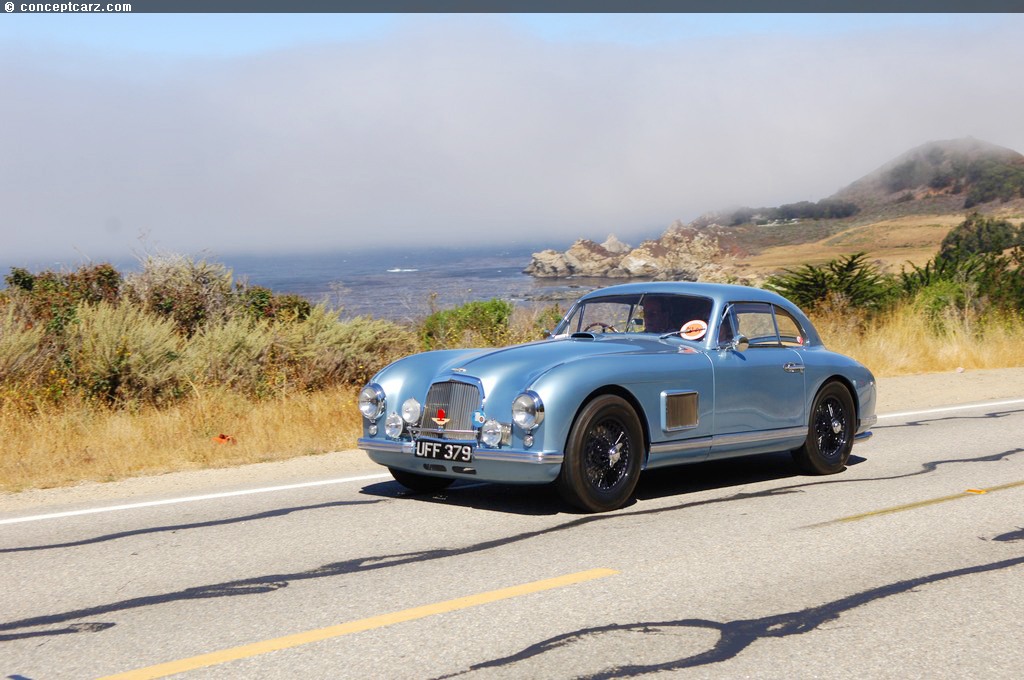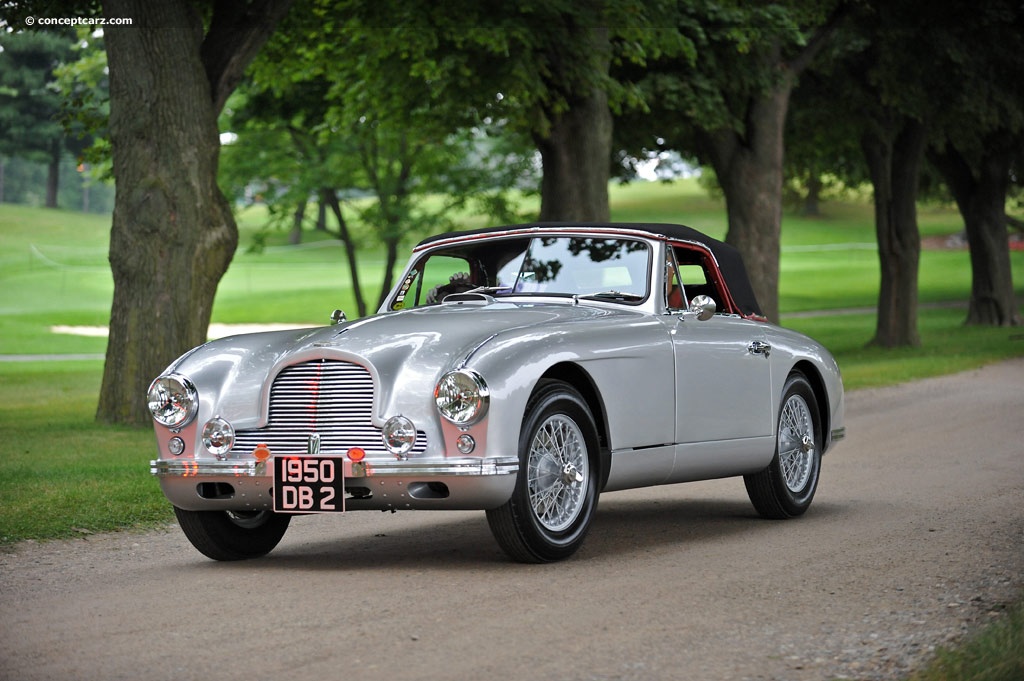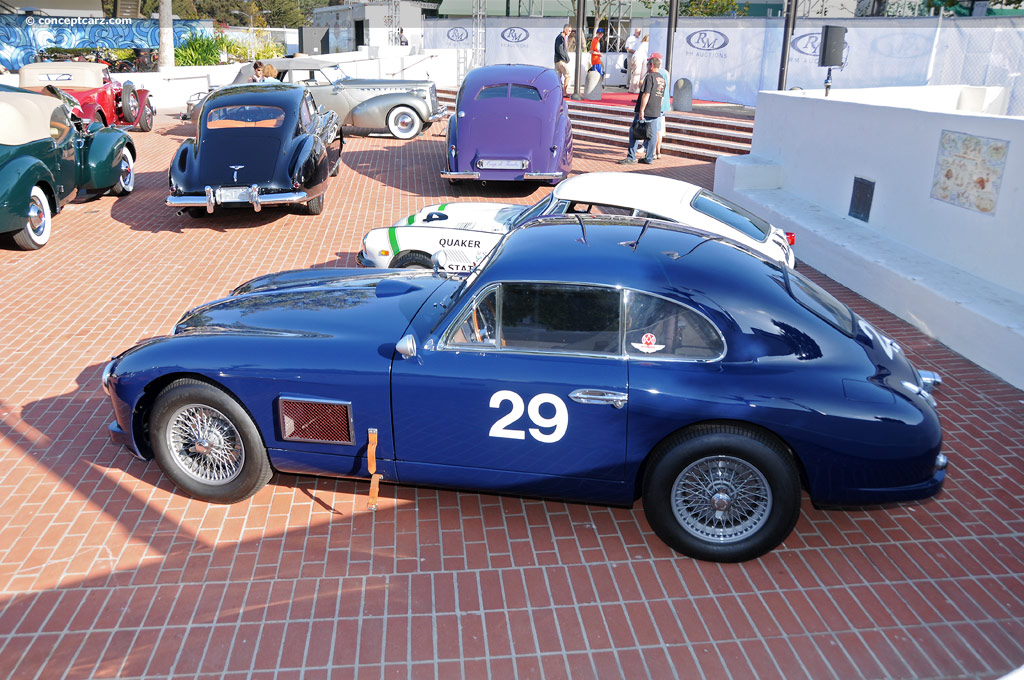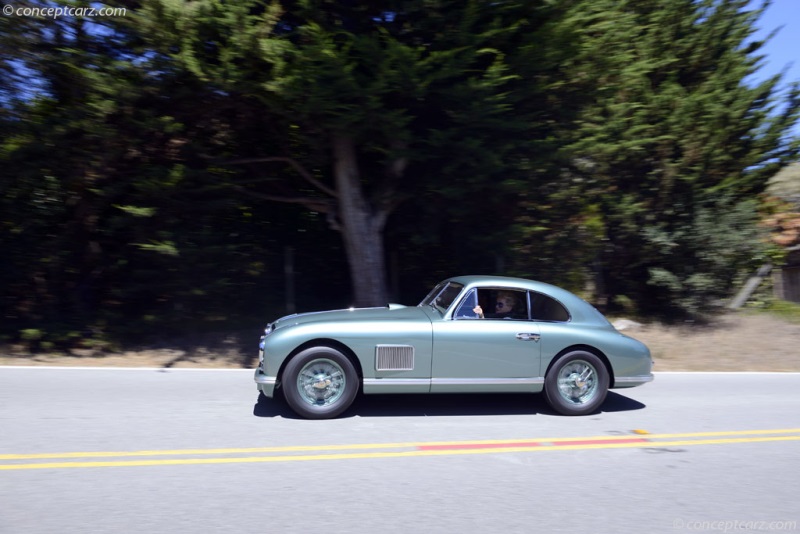The history of Aston Martin dates back to 1913 when it was founded by Lionel Martin and Robert Bamford. The next three decades were met with competition success, low production numbers, and financial difficulties, with approximately 700 vehicles produced during this time. 
DropHead Coupe by TickfordFollowing World War II, Aston Martin was rescued by David Brown Limited, manufacturer of Huddersfield gear and machine tools, and put it under the control of its Tractor Group. A few months later, they added the Lagonda Company to its portfolio, which provided a modern 2,580 cc twin-overhead cam six-cylinder engine, the work of W.O. Bentley. This engine was used in a shortened Aston Martin '2-litre Sport' tubular-steel chassis and clothed in Frank Freely's distinctive sports-tourer bodywork. In various forms, this engine design would continue to power Aston Martin's DB2, DB2/4, and DB Mark III road cars through 1959, as well as the DB3 and DB3S sports racers.Prior to making its road-going debut, the fully-fledged DB2 competition cars made their introduction on the Le Mans track in 1949. Under the guidance of team manager John Wyer and newly-hired drivers, including Jack Fairman, Lance Macklin, George Abecassis, and Reg Parnell, motorsport competition began in earnest with the prototype DB2 models of 1949. A Le Mans class podium finish was earned by LML/49/3 in 1949, followed by the entry of a trio of DB2s in 1950 (LML/50/7, 50/8, and 50/9), earning two class awards. Next came the DB3 and 3S competition cars, which continued to carry the racing pedigree forward from 1952 through 1956. The culmination of the Works team's efforts was in 1959, when the DBR1, driven by Roy Salvadori and Carroll Shelby, won Le Mans outright. With additional help from drivers such as Stirling Moss, Jack Fairman, and Tony Brooks, Aston Martin captured the World Sports Car Championship that year.During the 1959 to 1969 era, the very successful DB4, DB5, and DB6 Grand Tourers were powered by a new alloy twin-cam six. In 1969, a new V-8 engine made its debut, and versions of this alloy engine would power post-David Brown era Astons for the next two decades. Knighted in 1968, Sir David Brown's 25-year stewardship had begun with the DB1 (a four-cylinder pushrod 2.0-liter model), and the landmark DB2 which remained in series production from May 1950 until April of 1953.
DropHead Coupe by Tickford
Chassis #: LML/50/217
Engine #: VR6B/50/1082
View info and historyBeginning with the prior two-liter sports model chassis, newly hired engineer Ted Cutting shortened the wheelbase, added cruciform frame members, triangulation, and an extra upper side-rail, essentially creating a stiff tubular space-frame platform. The suspension was comprised of an advanced four-wheel coil spring setup that was not duplicated on other marques, such as Jaguar or Ferrari, for at least a decade. The front suspension was independent while the rear used a Salisbury hypoid live axle located by trailing arms and a Panhard rod. 12-inch hydraulic drum brakes provided the stopping power, with many examples fitted with the optional Alfin aluminum drums for competition use.The 2.6-liter twin-cam engine, designed by W.O. Bentley in 1943, ranged from 105- to 145- horsepower at 5,000 RPM (depending on configuration), and delivered a zero-to-sixty mph time of about twelve seconds and a top speed of 110 to 135 miles per hour. It was more powerful than the pushrod 2.0-liter straight-4 unit found in the prior 2-Liter Sports, and in original form, the Lagonda straight-6 had a 78 mm bore and 90 mm stroke and came with dual SU carburetors. The four-speed gearbox was sourced in-house from the David Brown Gear Division.The DB2 was introduced in April of 1950 at the New York Auto Show and remained in production until April of 1953, by which time 411 examples had been produced.
Early examples received a three-par grille and a substantial slatted vent behind each front wheel, earning it the nickname 'Washboard.' The design was simplified after an initial run of 49 cars, and thereafter the side vent was removed and the three-piece grille replaced by a single unit.
DropHead Coupe by Tickford
Chassis #: LML/50/13
Auction entries : 1The single-piece front bonnet was hinged at the front, while the rear of the fixed-head coupe (FHC) used a small top-hinged lid to allow access to the spare wheel. Luggage space was located behind the front seat, accessible only from inside the car. The FHC was joined in late-in-1950 by a Drophead Coupe (DHC) and at least 102 examples of this body style were built. The first Vantage upgrade became available in April of 1950, complete with larger carburetors, higher compression ratio pistons (8.16:1), and inlet camshafts the same as the exhaust. The higher compression ratio was initially unsuitable for the British market as it restricted vehicles to 72 octane 'Pool petrol.' The first 125 horsepower DB2 Vantage (LML 50/21) was delivered to Briggs Cunningham in the United States.
by Daniel Vaughan | Sep 2020

DropHead Coupe by Tickford

DropHead Coupe by Tickford
Chassis #: LML/50/217
Engine #: VR6B/50/1082
View info and history
Early examples received a three-par grille and a substantial slatted vent behind each front wheel, earning it the nickname 'Washboard.' The design was simplified after an initial run of 49 cars, and thereafter the side vent was removed and the three-piece grille replaced by a single unit.

DropHead Coupe by Tickford
Chassis #: LML/50/13
Auction entries : 1
by Daniel Vaughan | Sep 2020
Related Reading : Aston Martin DB2 History
The Aston Martin DB2 was introduced to the public at the New York Motor Show. This was not the vehicles first appearance as it had been raced at the grueling 24 Hours of LeMans where one of the drivers, Pierre Marechal, had been involved in a fatal accident. The DB2 was designed by Frank Freeley and configured as a two-seater touring vehicle. It was Aston Martins first real production vehicle. The....
Continue Reading >>
Continue Reading >>
Related Reading : Aston Martin DB2 History
The first Aston Martin was built in 1913 by London Singer dealers Robert Bamford and Lionel Martin. It was comprised of a Coventry Simplex engine and an Isotta Fraschini chassis. They were later joined by Count Louis Zborowski, who provided finical backing and was an avid racer. Under the patronage of Augustus Bertelli, the legacy of Aston Martin continued to grow in motorsports throughout the years.....
Continue Reading >>
Continue Reading >>
1950 Aston Martin DB2 Vehicle Profiles
Recent Vehicle Additions
Related Automotive News

Genuine 'Bond' Aston Martin DB5 Leads British Rarities at Concours of Elegance 2023
Great British cars from road and track announced for Concours of Elegance
4.5 Litre from legendary clean-sweep Bentley 1929 Le Mans team
Bentley Old Number One – arguably British motor sports most significant car
Ex-Collins, Moss, Salvadori...

Donald Campbell's DB4 GT Speeds into Bonhams Goodwood Revival Sale
A rare 1961 Aston Martin DB4 GT, one of only 45 right-hand drive examples produced and first privately owned by Donald Campbell CBE, the world land and water speed record breaker, is to be offered at the Bonhams Goodwood Revival Sale on Saturday 14 September,...

ASTON MARTIN DB3S TO HEADLINE BONHAMS ASTON MARTIN AUCTION
17th specialist auction to take place on Saturday 21 May at Aston Martin Works, Newport Pagnell
11 May, 2016, Gaydon The expected star of the show at the forthcoming Bonhams Aston Martin auction is a 1953 Aston Martin DB3S, raced by Sir St...

The 1954 Aston Martin DB3S: Car Of The Silver Screen Raced By The Great Stirling Moss
A rare Aston Martin Works team car – chassis number DB3S5 – which was campaigned in period by such legendary racing drivers as Sir Stirling Moss, Peter Collins and Roy Salvadori, and latterly went on to co-star with Terry-Thomas in 1960s movie classic...

1956 24 Hours of Le Mans: Collins and Moss Come Close
The 1955 24 Hours of Le Mans would be forever remembered, not for the 24 hours of racing, but for the tragic and terrible events that would take place after just two. The consequences would be dire and would send shockwaves throughout the racing world....





































